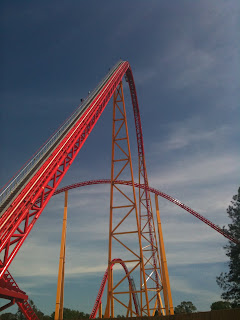
Only in the South would you find a roller coaster based on NASCAR. And only in the South would it be the best Ride in the park. Kings Dominion of Doswell, Virginia is home to this monster of a Ride. Yeah, I capitalized Ride. Intimidator 305 deserves it.
Quite frankly, it is the most physically demanding ride I have experienced. It starts with a 305-foot climb into an 300-foot drop pulling the train to a screaming 94 mph. After the descent, you’re immediately pulled into a horizontal loop, during which most passengers find themselves losing their vision as all their blood is centrifuged from their heads. And that’s in the first 15 seconds of the ride.
The worst (or BEST) part of the ride for me wasn’t the screaming speed, or the insane Gs. It was the sudden orientation switches. You’d be riding along at a frightening speed, when the track suddenly twists beneath you, flipping you to the side. It’s not a long corkscrew effect either. One second you’re upright, the next you’re sideways, with no transition time. I wasn’t aware how jarring this could be my first time around, and I naively kept my head up and away from the back as I screamed my brains out. Mistake. Upon hitting that first switch I was wrenched to the right so hard that the seat harness actually struck my neck. I walked around with a sore neck for the rest of the day. Fortunately, I had so much adrenaline in my system that I didn’t notice it much.
In my opinion, Kings Dominion is worth visiting for this Ride ALONE. Even if it weren’t, they have at least 5 other rides in the park well worth the visit, including the world’s tallest, fastest drop tower.
-Jake
Ok, so when you first get to see the ride your reaction is pretty much, “What is that big red thing?”, and “Wow, that is really high up”. The Intimidator is definitely an awesome ride. Jake and I tend to differ in what we really enjoy about certain coasters. While he enjoys extreme drops I tend to enjoy the sensations of being flung outward, inward, downward or other directions (yay gravity). The initial drop at 94 mph was totally sweet, but I was still hoping that was not all there was to it. I was right. There is nothing quite like falling down a drop at 94 mph (unless you do it faster), however, right after the 94 MILE PER HOUR DROP, as my esteemed compatriot mentioned, there is a horizontal loop. This means you are traveling on the inside of a loop on the horizontal axis. Doing this at 94 mph is insane. Your reaction may go something like this.
1) Yay that drop was really fun
2) Oh goody an inside loop I love those
3) Wow I am getting sucked into my chair
4) Hey, it’s getting hard to see
5) Hey, my vision is going away I am going to try and keep it
6) I lost my vision
7) My eyes are crying
8) My vision didn’t come back right away.
As it turns out, Jake and I found out we have differing blood pressures based upon this section of the ride (lol). I would also like to add that the instant jerks have you feeling like a fighter pilot banking in an F-15. What does that feel like? Ride the ride.
-Nate

